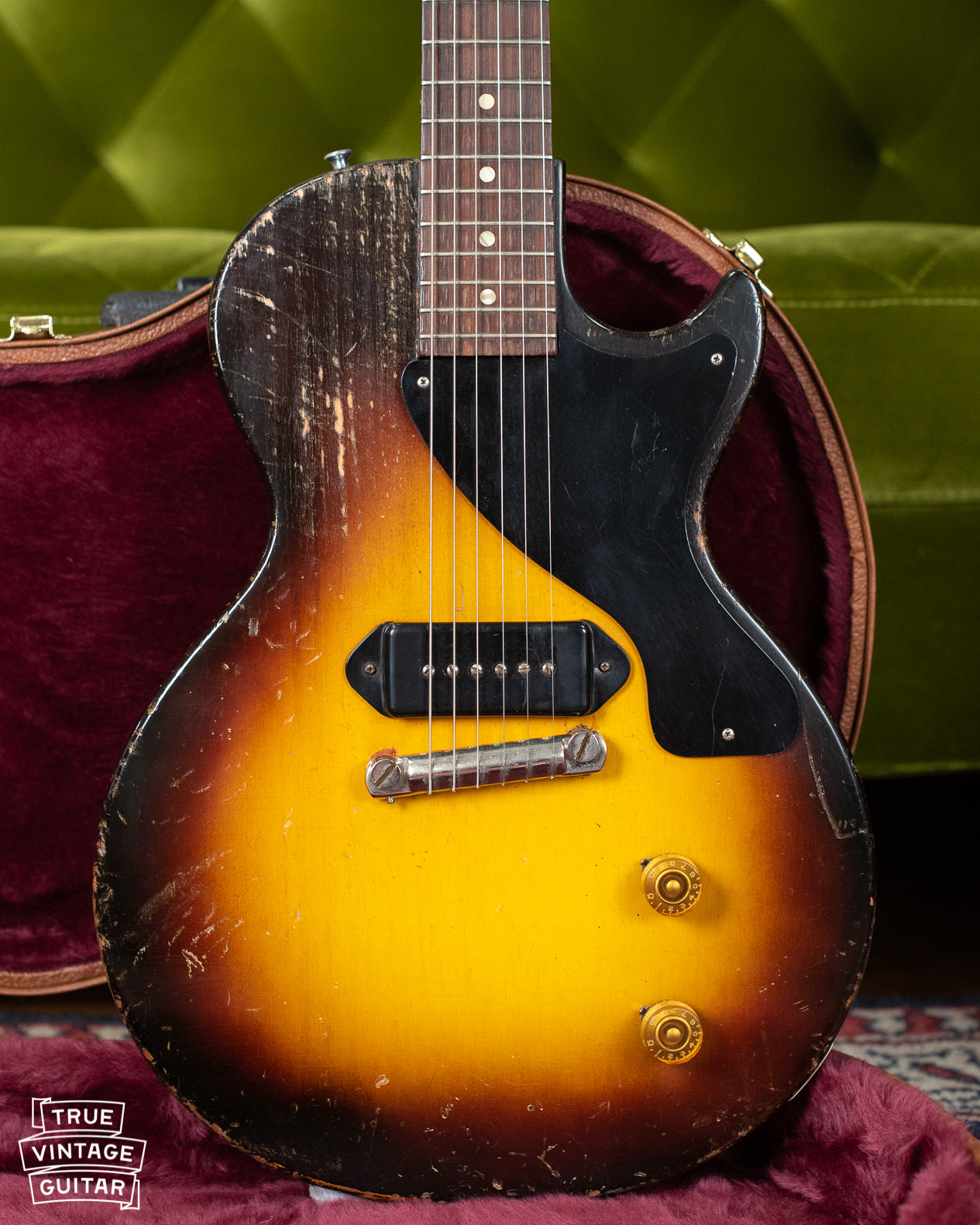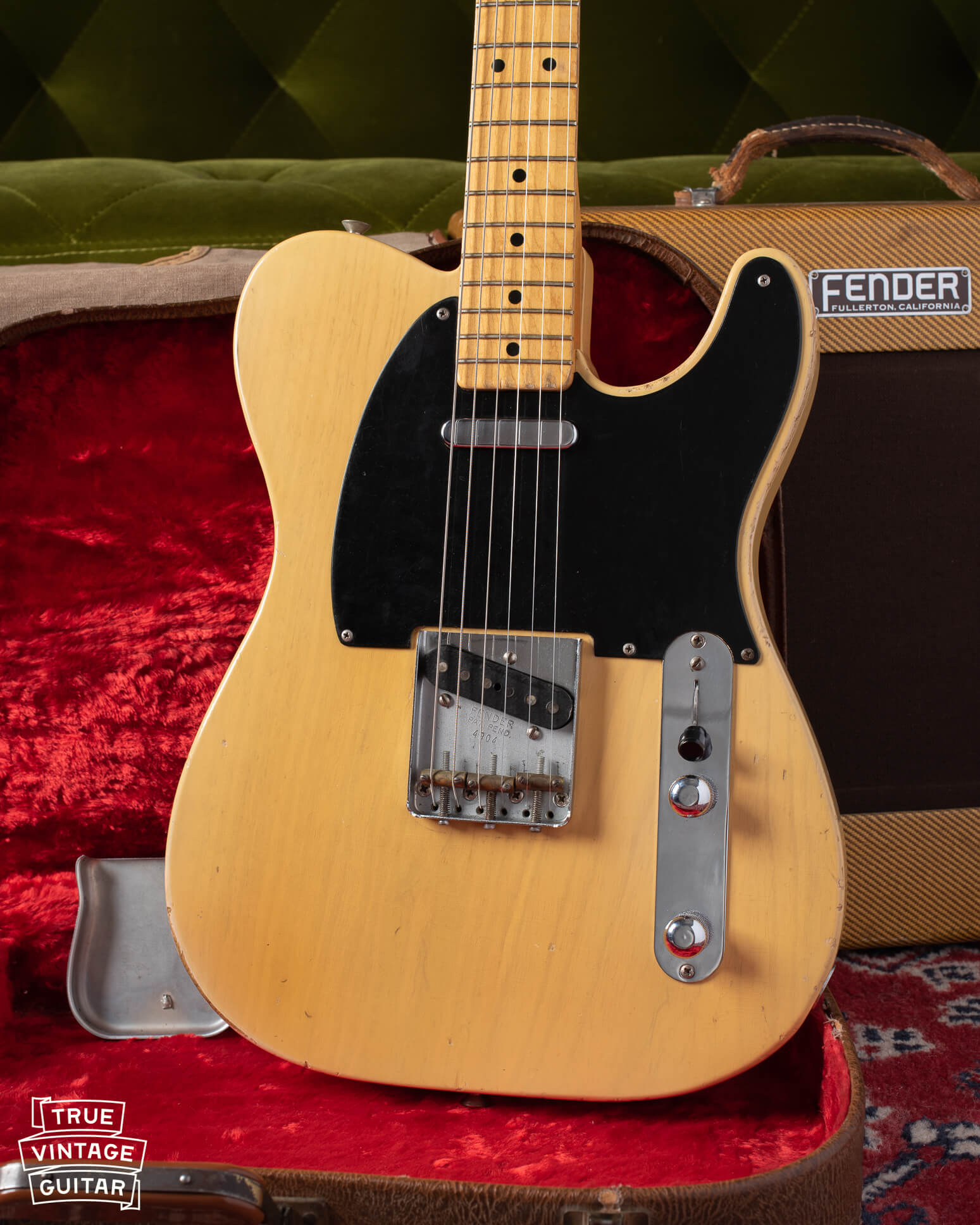The Fender Stratocaster made in 1963 is among my favorite vintage guitars ever made because of its value, tone, and original design. The Stratocaster model was only 9 years old in 1963, but the manufacturing style and tone are vastly different from what Fender made in the 1950s. This page will give helpful information about the '63 Stratocaster and some nice examples of different factory color options.
We appraise, authenticate, and buy original Fender Stratocasters from the 1950s and 1960s: Sell a Fender.
Jump to the 1963 Stratocaster information you're looking for:
Price: How much did a Stratocaster cost in 1963?
Changes: How did the Stratocaster change in 1963?
Measurements: Examples including neck, pickups, and weight

Fender Stratocaster Price in 1963
Fender published both a catalog and a price list for each year that dealers would use to order and sell the guitars (check out Stratocaster Values for today's value of a 1963 Stratocaster). The price list below is actually a Canadian price list from July of 1962, but the price would have stayed the same for most of 1963 as well. The price of a Fender Stratocaster in 1963 was $259.50 in the US, but in Canada it was $435.00b during the same time period. It's interesting that the Canadian price list below from 1962 doesn't offer some of the special options that the US price list offers including the Blond or custom colors or the gold hardware option.
I am looking to buy original Fender Stratocasters: Sell a Fender.

How the Stratocaster Changed In 1963
The 1963 Stratocaster sits at the intersection of build quality, value, and collectibility. The coveted slab Rosewood style fretboard on Stratocasters made between 1959 and 1962 is now updated to a slightly thinner veneer Rosewood fretboard. But the other features that make vintage Strats special remain: a light weight alder body (for all colors except Blond), a three layer nitrate pickguard (mint green), a thin finish, and now a slightly fuller neck profile. The pre-CBS black bobbin pickups retain the classic Stratocaster tone.
I am looking for Stratocasters from 1963: Sell a Fender.
Here are the most important updates to the Stratocaster in 1963:
Neck profile: The fatness of the neck increases a few hundredths of an inch at the first fret (on average). Also, the shoulders of the neck become slightly wider.
Pickguard: The pickguard screw between the neck and middle pickups shifts downward closer to the middle pickup.
Neck pocket: The "paint stick" pattern in the neck pocket slowly phases in (all '64s have it, but not all '63s).
Undercoat: The undercoat color for most of the custom colors becomes bright pure white instead of the earlier style desert sand color.
Did I miss any? Leave me a comment below.

1963 Stratocaster Neck, Pickups, and Weight
It's my goal to catalog and measure as many 1963 Fender Stratocasters to record measurements for the necks, pickups, and body dates. Below are some data which may be useful for those who love original '63 Stratocasters.
I'm looking to buy original 1963 Stratocasters: Sell a Fender
1963 Stratocaster Neck Measurements:
L15877 (Sunburst, November neck date): 0.82" deep at the first fret and .99" deep at the 12th fret, 1.65" / 42 mm wide at the nut.
89904 (Sunburst, February neck date): 0.81” deep at the 1st fret and 1.00” at the 12th fret.
92191 (Sunburst, January neck date): 0.82" deep at the first fret, and 1.01" deep at the 12th fret
1963 Stratocaster Pickup Measurements:
L15877: 5.87k ohms, the middle reads 6.34k ohms, and the bridge pickup reads 5.98k ohms
89904: Neck = 5.59k ohms, middle = 5.56k ohms, bridge = 5.57k ohms
92191: Neck = 5.58k ohms, middle = 6.27k ohms, and bridge = 6.11k ohms
1963 Stratocaster Weight Measurements:
L15877 (November '63): 8 lbs / 3.65 kg total weight
89904 (February '63): 7.8 lbs / 3.50 kg total weight
92191: (January '63) 7.7 lbs / 3.50 kg total weight
I'm looking to buy original 1963 Stratocasters: Sell a Fender
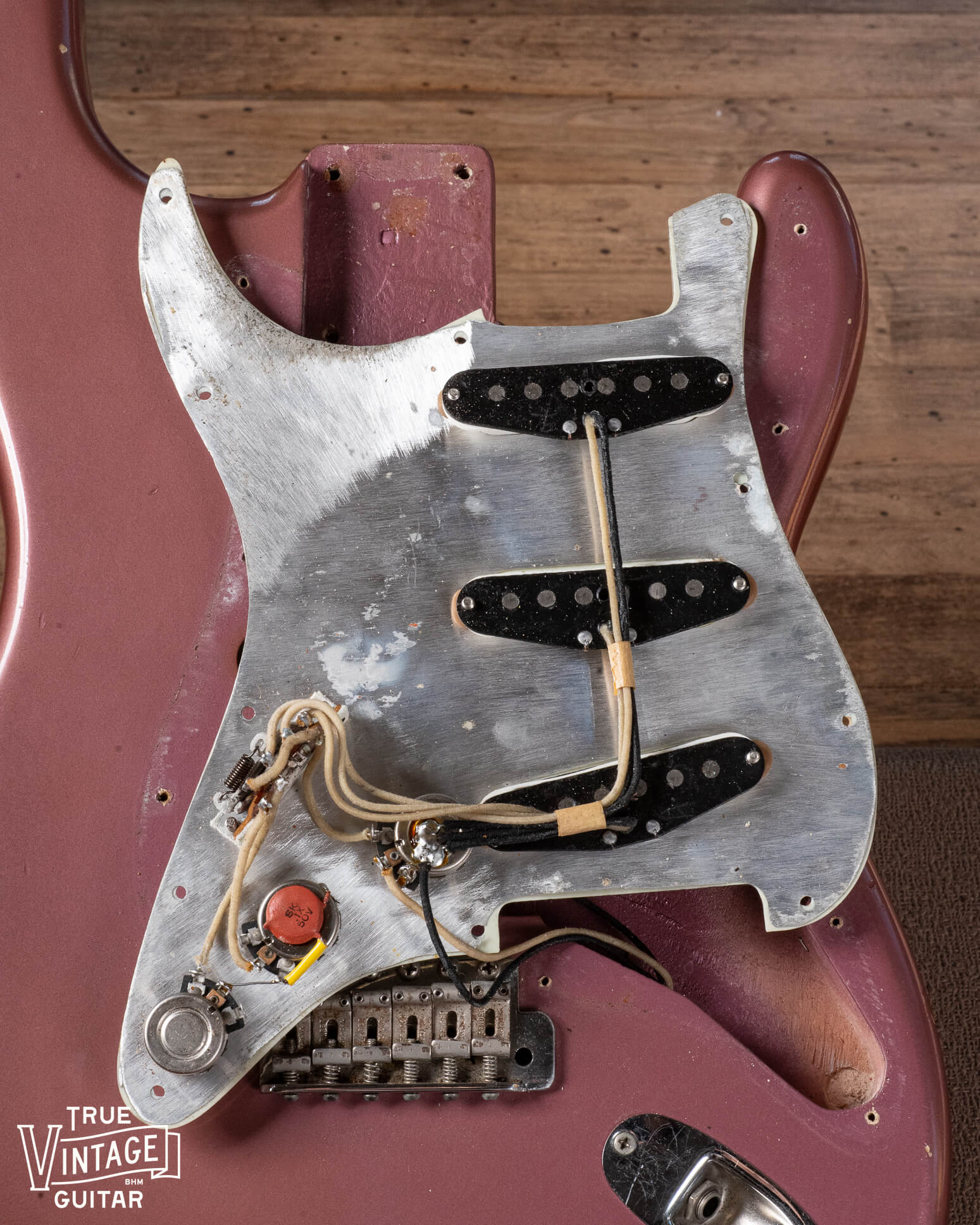
Color options for Stratocasters in 1963
Fender offered the standard Sunburst color for the Stratocaster but a custom color could be ordered from a chart for 5% extra. The most popular colors in '63 were Candy Apple Red and Olympic White, but Black, Fiesta Red, and Lake Placid Blue were also available and commonly ordered. But some of the rarest colors include Burgundy Mist Metallic, Sherwood Green, Surf Green, and Foam Green. These colors are difficult for collectors to find and can bring a premium price over the typical Sunburst and common colors. You can check out the custom color chart here: Fender Custom Color Chart 1964.
I am looking for all custom color Stratocasters: sell a Fender.

As a Fender guitar collector, I'm always on the hunt for the nicest examples of Fender Stratocaster guitars, but especially from 1963. If you're looking for help with Fender guitar dating then check out Fender Serial Numbers. If you're curious about the value of your Stratocaster then read this: Stratocaster Values. Or if you're interested finding a buyer for your Stratocaster, you can reach me here: Sell a Fender.
 |

|
1963 Stratocaster 89904
The Stratocaster bearing the serial number "89904" was sold to the neighbor of its first owner in the early 1970s. The neighbor was already Fender guitar fan in that he was the original owner of this 1953 Telecaster. He was a hobbyist country guitar player who enjoyed his guitars until he passed a few years ago. I flew into Phoenix, Arizona to meet with his son and buy both guitars in person.
As a Fender guitar collector, I'm always looking for the best examples of Fender guitars from the 1950s and 1960s. You can contact me here to sell a Fender.

|
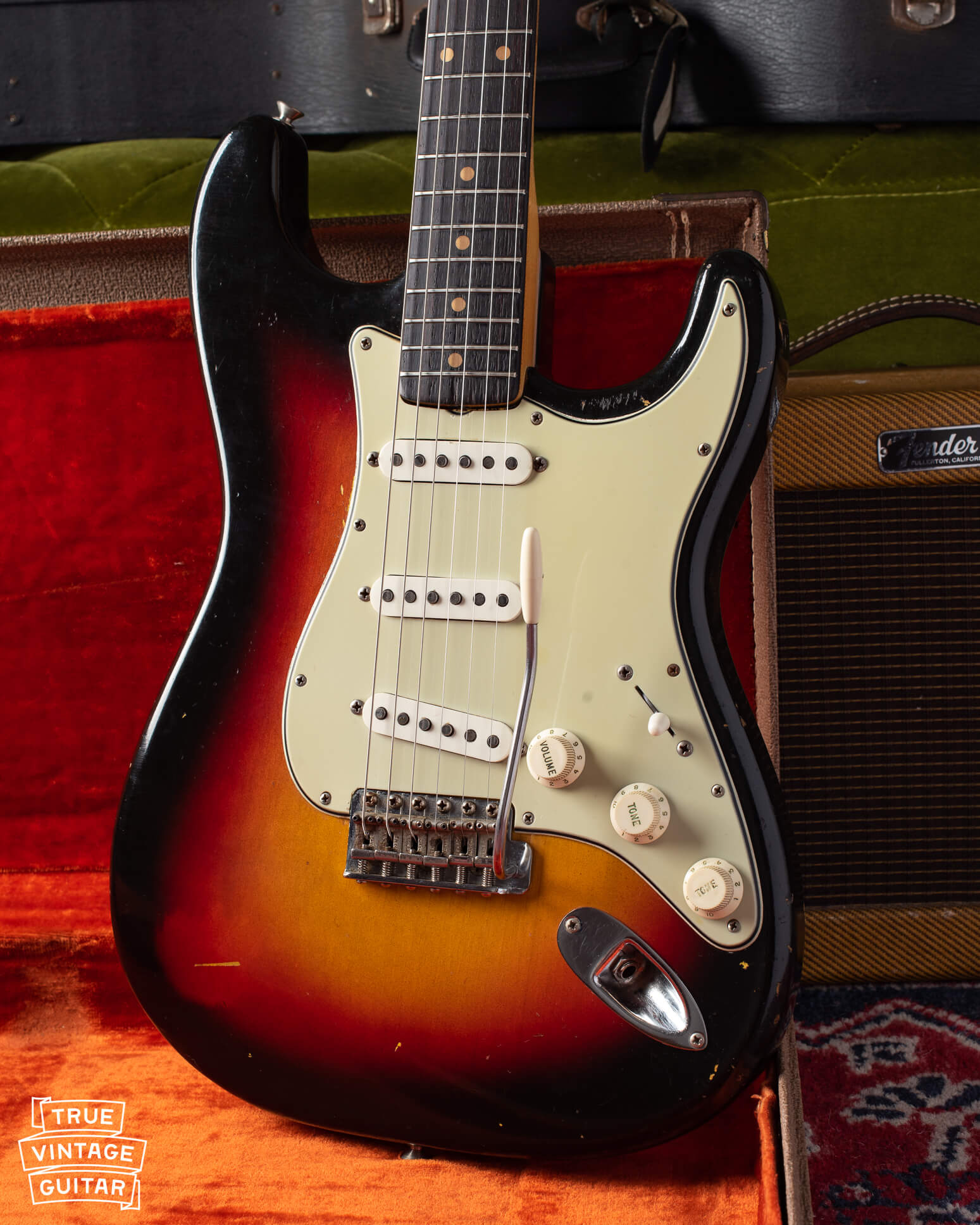 |
|
1963 Stratocaster 89904 Important Measurements: Weight: 7.8 lbs / 3.50 kg Neck profile: 0.81” deep at the 1st fret and 1.00” at the 12th fret Pickup resistance readings: Neck = 5.59k ohms, middle = 5.56k ohms, bridge = 5.57k ohms Neck heel ink stamp: "2FEB63B" where "2" = Stratocaster model, FEB = February, 63 = 1963, and B = standard neck width 1 5/8" Tremolo cavity date: "7/63" in pencil |
 |
 |

|
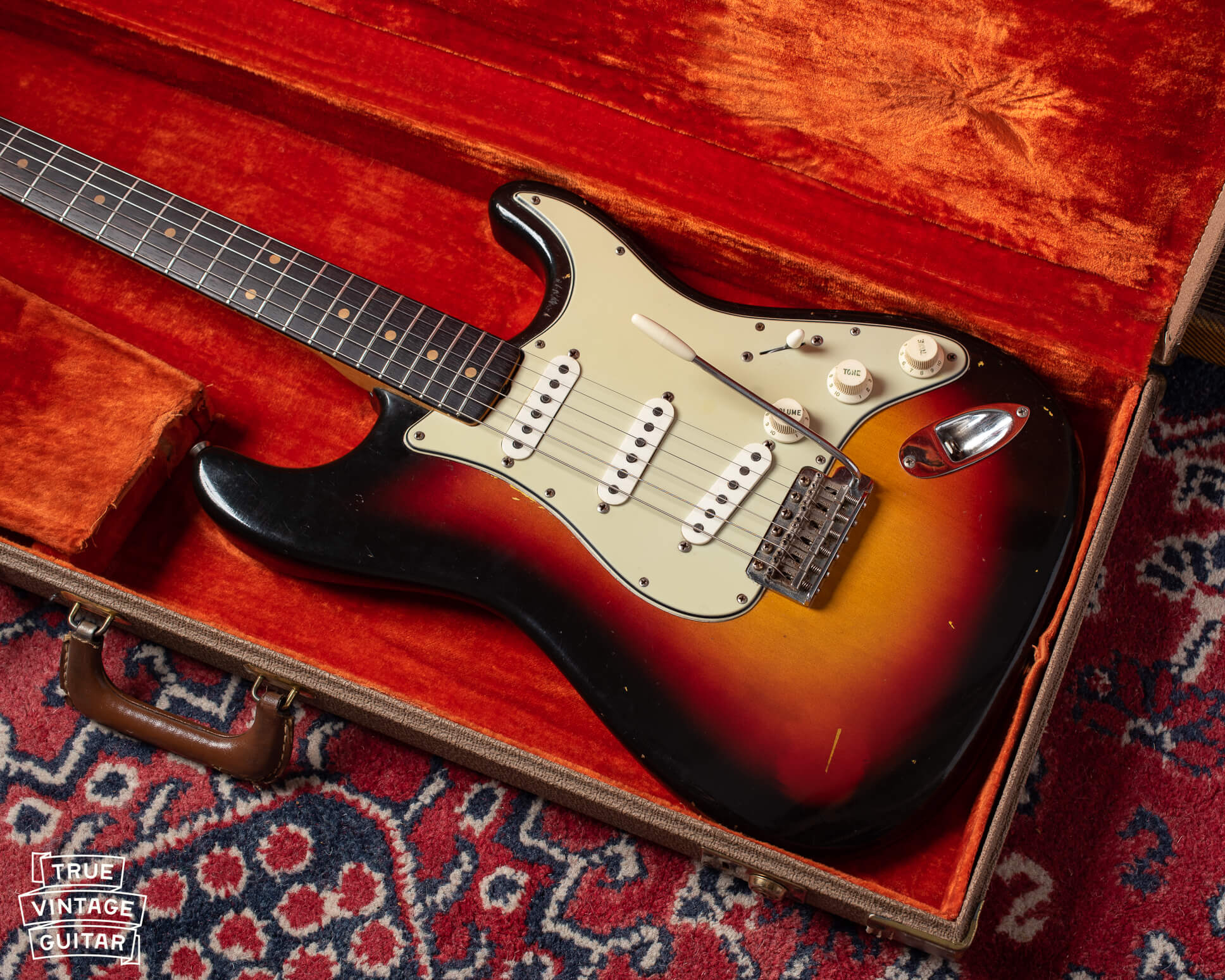
|
 |
1963 Stratocaster L20205
The second 1963 Fender Stratocaster that I've had the privilege to own is serial number L20205 from Denver, Colorado. The story of this Strat is similar to the others in that the seller was its original owner's son. Both his dad and his uncle bought matching Stratocaster guitars in 1963 and held onto them throughout their lifetime. His dad passed away a few years ago and it was time to sell the guitar.
Are you considering selling a 1963 Stratocaster? I'd love to take a look: Sell a Fender.
1963 Stratocaster L20205 was another great example of one of the finest years for the model. Like many pre-CBS Strats, the original frets were very worn and the middle pickup wasn't working. I asked the luthier I work with to refret the guitar with factory size and shape frets so that it would play exactly as the manufacturer intended it to play. I then sent the entire guitar off to have the middle pickup checked to see if it would repair. The insulation on the coil wire was degraded to the point that the coil was shorting out so a rewind was required. It's now a spectacular playing example.
1963 Stratocaster L20205 Year Identifiers
Serial number: L20205
Neck heel ink stamp: "2NOV63B" (2 = Stratocaster model, 63 = 1963, NOV = November, B = standard nut width 1 5/8".
Potentiometer code: "137 6343" (137 = Chicago Telephone Supply, 63 = 1963, 43 = 43rd week).

|
 |
 |

|
 |

|
1963 Stratocaster Features
The Stratocaster was in production for nine years by 1963, but the overall shape and design was still exactly the same. The Strat's one piece Maple neck and lacquered fretboard now had an unfinished Rosewood laminate overlay. Much has been said about the quality of the thick slab fretboard made from 1959 until 1962, but I've found that the veneer boards in the early 1960s are in no way inferior in tone or construction. The veneer fretboards from late 1962 until 1964 are slightly thicker than the later veneers. You can spot the early style veneer by the straight line making the transition from Rosewood to Maple up at the top of the headstock. What collectors refer to as "clay dots", the brown fretboard position markers made of vulcanized fiber, won't be updated to pearloid until 1965.
Check out this page for a full account of every part that an expert uses to find the year of a Stratocaster: How to date a Stratocaster.
Also of note, the finish styles on the Strat change slightly in 1963. For Sunburst finishes, the red band is smaller than in 1962 making the yellow center a bit larger. The opaque yellow dip which makes up the undercoat for Sunburst finish won't be in use until 1964. For custom color finishes, the formally desert sand color undercoat is updated to a bright white undercoat. The pickguards remain the attractive "mint green" color and are prone to shrinking.
On the neck of the 1963, the spaghetti style Fender logo should be present with three patent numbers underneath. Fender would add another patent number to the sticker in 1964, then update the logo to the thicker style transitional logo later in the year. The thin lettering Fender logo commonly referred to as the spaghetti logo had been in use on the Stratocaster in various forms since its introduction in 1954. The headstock shape remains the small variety which was enlarged in late 1965. The Strat's tuners are single line Kluson tuners with hollow posts to accept the end of the string. This keeps the headstock looking clean and avoids the pesky poke by the sharp string ends from other tuners. The double line Kluson style tuner would be introduced a year later.
Under the pickguard, the Stratocaster's pickups remain largely the same constuction as before with black flatwork top and bottom. The three position switch that the model was introduced with remains until the 1970s. This three position switch neglects the ever popular in-between pickup positions which I've come to love for the wide and flat frequency response and unique tone which excites the listener. I do not personally find the three position switch to be a hinderance to playing, in fact, I've found that it encourages me to listen even closer for the exact tone I'm looking for while hunting for the in-between position. It's one of my favorite parts of pre-CBS Stratocaster guitars.
Stratocaster Collector
If you've inherited a Fender Stratocaster and are considering selling then I would love to take a look at it. I'm looking for the nicest examples of all 1950s and 1960s Stratocaster guitars. My primary goal is to collect all colors of Stratocaster guitars on the custom color chart. You can contact me here to sell a Fender.
Check out a few other great pre-CBS Stratocasters I've had here:
1962 Stratocaster Fiesta Red Gold Hardware
I am always on the hunt for custom color Fender guitars so please contact me if you are looking to sell.

